Research Methods for Law: Benefits and Limits of Doctrinal Research
VerifiedAdded on 2020/03/16
|15
|3758
|39
Essay
AI Summary
This essay analyzes the doctrinal research method, a cornerstone of legal studies, evaluating its benefits and limitations. It defines doctrinal research as a theoretical approach focusing on legal doctrines, principles, and case laws, contrasting it with socio-legal research. The essay highlights the advantages of doctrinal research, such as providing quick answers, ensuring logical consistency of legal principles, contributing to a better understanding of law, and aiding in theory building. It also acknowledges the limitations, including potential subjectivity, a lack of consideration for social values and facts, and a reliance on traditional legal sources. The essay emphasizes the need for a balance between doctrinal and socio-legal research to address the complexities of law and its impact on society. The evolution of patent law is also considered as an example. It concludes by suggesting the importance of considering extra-legal factors for effective lawmaking. The essay provides a comprehensive overview of the doctrinal research method in law.

Paraphrase This Document
Need a fresh take? Get an instant paraphrase of this document with our AI Paraphraser
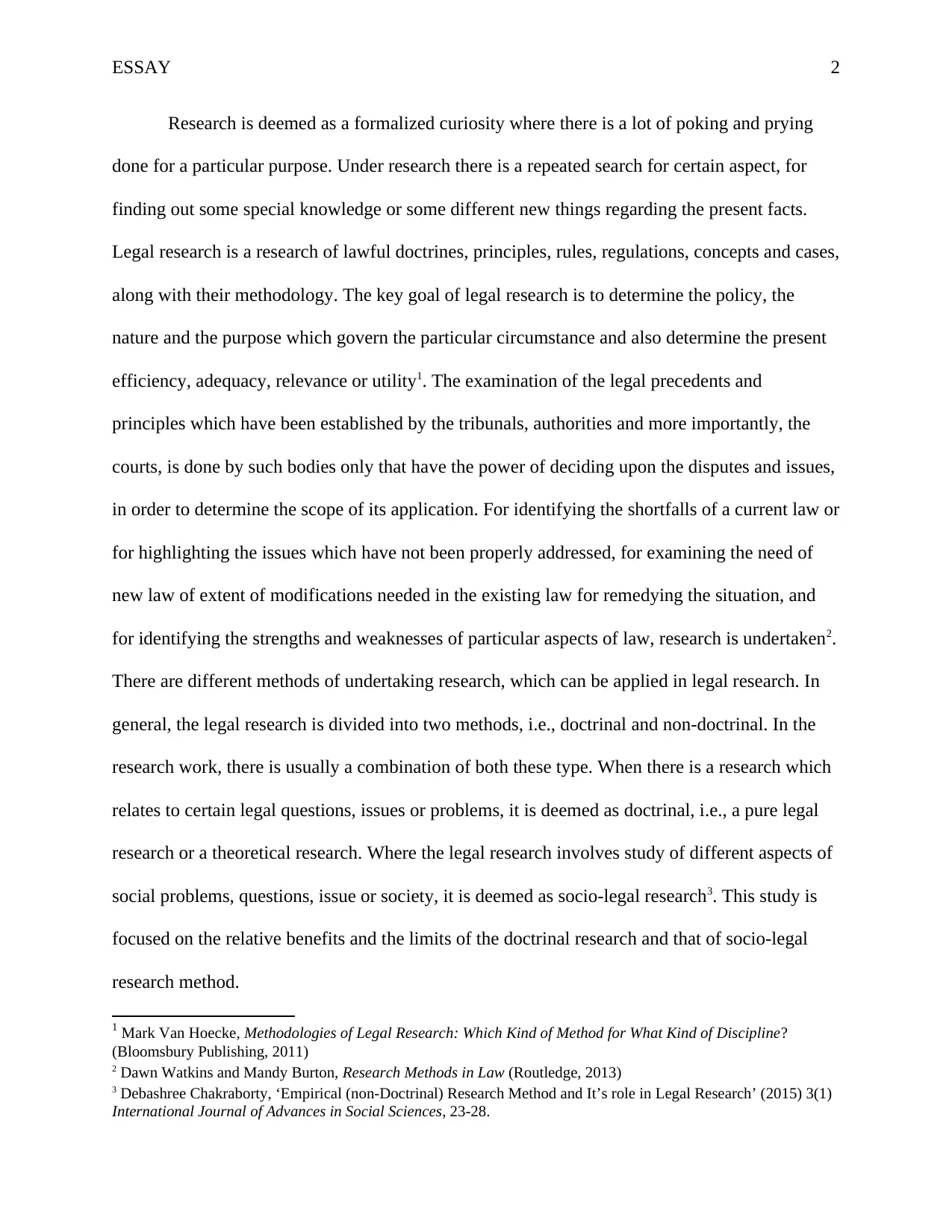
ESSAY 2
Research is deemed as a formalized curiosity where there is a lot of poking and prying
done for a particular purpose. Under research there is a repeated search for certain aspect, for
finding out some special knowledge or some different new things regarding the present facts.
Legal research is a research of lawful doctrines, principles, rules, regulations, concepts and cases,
along with their methodology. The key goal of legal research is to determine the policy, the
nature and the purpose which govern the particular circumstance and also determine the present
efficiency, adequacy, relevance or utility1. The examination of the legal precedents and
principles which have been established by the tribunals, authorities and more importantly, the
courts, is done by such bodies only that have the power of deciding upon the disputes and issues,
in order to determine the scope of its application. For identifying the shortfalls of a current law or
for highlighting the issues which have not been properly addressed, for examining the need of
new law of extent of modifications needed in the existing law for remedying the situation, and
for identifying the strengths and weaknesses of particular aspects of law, research is undertaken2.
There are different methods of undertaking research, which can be applied in legal research. In
general, the legal research is divided into two methods, i.e., doctrinal and non-doctrinal. In the
research work, there is usually a combination of both these type. When there is a research which
relates to certain legal questions, issues or problems, it is deemed as doctrinal, i.e., a pure legal
research or a theoretical research. Where the legal research involves study of different aspects of
social problems, questions, issue or society, it is deemed as socio-legal research3. This study is
focused on the relative benefits and the limits of the doctrinal research and that of socio-legal
research method.
1 Mark Van Hoecke, Methodologies of Legal Research: Which Kind of Method for What Kind of Discipline?
(Bloomsbury Publishing, 2011)
2 Dawn Watkins and Mandy Burton, Research Methods in Law (Routledge, 2013)
3 Debashree Chakraborty, ‘Empirical (non-Doctrinal) Research Method and It’s role in Legal Research’ (2015) 3(1)
International Journal of Advances in Social Sciences, 23-28.
Research is deemed as a formalized curiosity where there is a lot of poking and prying
done for a particular purpose. Under research there is a repeated search for certain aspect, for
finding out some special knowledge or some different new things regarding the present facts.
Legal research is a research of lawful doctrines, principles, rules, regulations, concepts and cases,
along with their methodology. The key goal of legal research is to determine the policy, the
nature and the purpose which govern the particular circumstance and also determine the present
efficiency, adequacy, relevance or utility1. The examination of the legal precedents and
principles which have been established by the tribunals, authorities and more importantly, the
courts, is done by such bodies only that have the power of deciding upon the disputes and issues,
in order to determine the scope of its application. For identifying the shortfalls of a current law or
for highlighting the issues which have not been properly addressed, for examining the need of
new law of extent of modifications needed in the existing law for remedying the situation, and
for identifying the strengths and weaknesses of particular aspects of law, research is undertaken2.
There are different methods of undertaking research, which can be applied in legal research. In
general, the legal research is divided into two methods, i.e., doctrinal and non-doctrinal. In the
research work, there is usually a combination of both these type. When there is a research which
relates to certain legal questions, issues or problems, it is deemed as doctrinal, i.e., a pure legal
research or a theoretical research. Where the legal research involves study of different aspects of
social problems, questions, issue or society, it is deemed as socio-legal research3. This study is
focused on the relative benefits and the limits of the doctrinal research and that of socio-legal
research method.
1 Mark Van Hoecke, Methodologies of Legal Research: Which Kind of Method for What Kind of Discipline?
(Bloomsbury Publishing, 2011)
2 Dawn Watkins and Mandy Burton, Research Methods in Law (Routledge, 2013)
3 Debashree Chakraborty, ‘Empirical (non-Doctrinal) Research Method and It’s role in Legal Research’ (2015) 3(1)
International Journal of Advances in Social Sciences, 23-28.
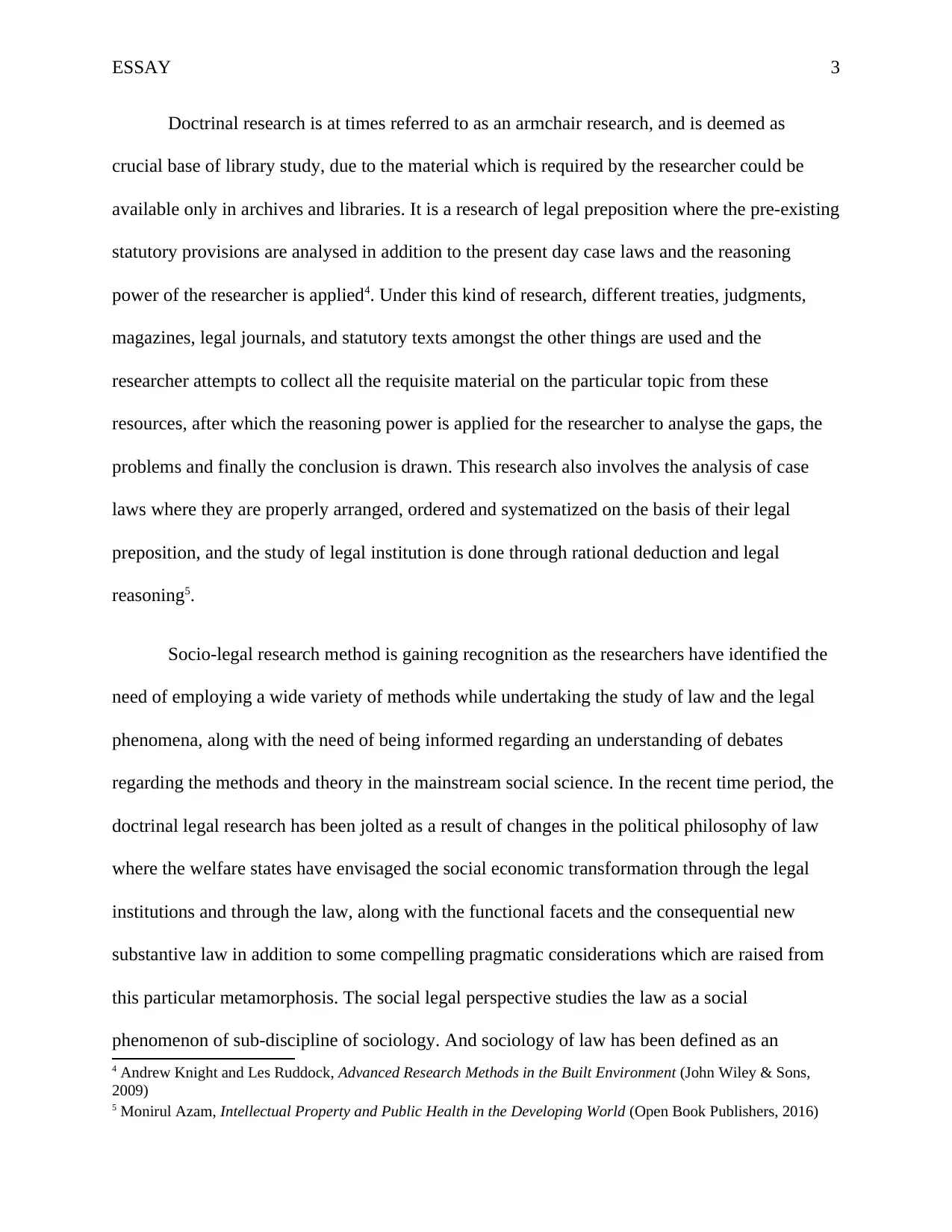
ESSAY 3
Doctrinal research is at times referred to as an armchair research, and is deemed as
crucial base of library study, due to the material which is required by the researcher could be
available only in archives and libraries. It is a research of legal preposition where the pre-existing
statutory provisions are analysed in addition to the present day case laws and the reasoning
power of the researcher is applied4. Under this kind of research, different treaties, judgments,
magazines, legal journals, and statutory texts amongst the other things are used and the
researcher attempts to collect all the requisite material on the particular topic from these
resources, after which the reasoning power is applied for the researcher to analyse the gaps, the
problems and finally the conclusion is drawn. This research also involves the analysis of case
laws where they are properly arranged, ordered and systematized on the basis of their legal
preposition, and the study of legal institution is done through rational deduction and legal
reasoning5.
Socio-legal research method is gaining recognition as the researchers have identified the
need of employing a wide variety of methods while undertaking the study of law and the legal
phenomena, along with the need of being informed regarding an understanding of debates
regarding the methods and theory in the mainstream social science. In the recent time period, the
doctrinal legal research has been jolted as a result of changes in the political philosophy of law
where the welfare states have envisaged the social economic transformation through the legal
institutions and through the law, along with the functional facets and the consequential new
substantive law in addition to some compelling pragmatic considerations which are raised from
this particular metamorphosis. The social legal perspective studies the law as a social
phenomenon of sub-discipline of sociology. And sociology of law has been defined as an
4 Andrew Knight and Les Ruddock, Advanced Research Methods in the Built Environment (John Wiley & Sons,
2009)
5 Monirul Azam, Intellectual Property and Public Health in the Developing World (Open Book Publishers, 2016)
Doctrinal research is at times referred to as an armchair research, and is deemed as
crucial base of library study, due to the material which is required by the researcher could be
available only in archives and libraries. It is a research of legal preposition where the pre-existing
statutory provisions are analysed in addition to the present day case laws and the reasoning
power of the researcher is applied4. Under this kind of research, different treaties, judgments,
magazines, legal journals, and statutory texts amongst the other things are used and the
researcher attempts to collect all the requisite material on the particular topic from these
resources, after which the reasoning power is applied for the researcher to analyse the gaps, the
problems and finally the conclusion is drawn. This research also involves the analysis of case
laws where they are properly arranged, ordered and systematized on the basis of their legal
preposition, and the study of legal institution is done through rational deduction and legal
reasoning5.
Socio-legal research method is gaining recognition as the researchers have identified the
need of employing a wide variety of methods while undertaking the study of law and the legal
phenomena, along with the need of being informed regarding an understanding of debates
regarding the methods and theory in the mainstream social science. In the recent time period, the
doctrinal legal research has been jolted as a result of changes in the political philosophy of law
where the welfare states have envisaged the social economic transformation through the legal
institutions and through the law, along with the functional facets and the consequential new
substantive law in addition to some compelling pragmatic considerations which are raised from
this particular metamorphosis. The social legal perspective studies the law as a social
phenomenon of sub-discipline of sociology. And sociology of law has been defined as an
4 Andrew Knight and Les Ruddock, Advanced Research Methods in the Built Environment (John Wiley & Sons,
2009)
5 Monirul Azam, Intellectual Property and Public Health in the Developing World (Open Book Publishers, 2016)
⊘ This is a preview!⊘
Do you want full access?
Subscribe today to unlock all pages.

Trusted by 1+ million students worldwide
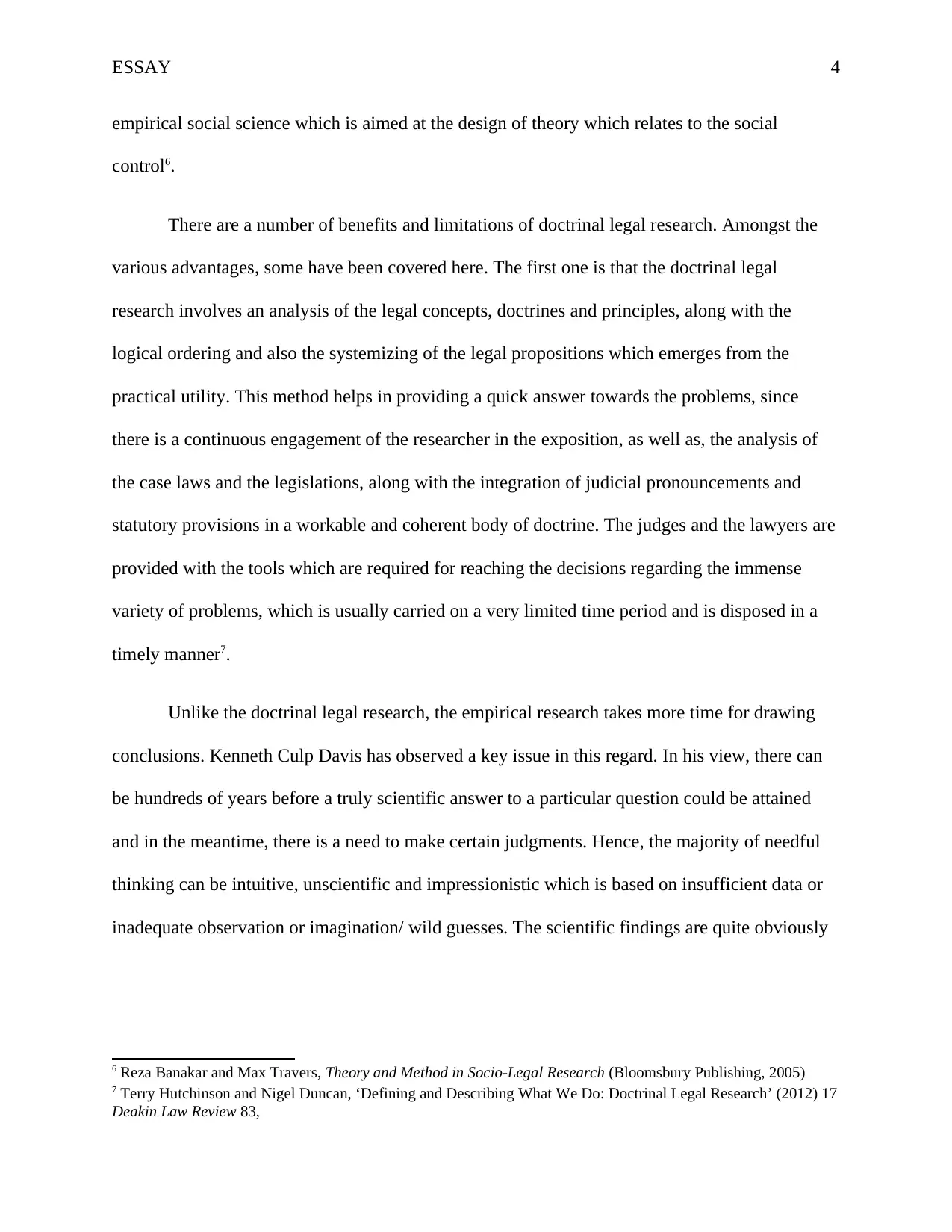
ESSAY 4
empirical social science which is aimed at the design of theory which relates to the social
control6.
There are a number of benefits and limitations of doctrinal legal research. Amongst the
various advantages, some have been covered here. The first one is that the doctrinal legal
research involves an analysis of the legal concepts, doctrines and principles, along with the
logical ordering and also the systemizing of the legal propositions which emerges from the
practical utility. This method helps in providing a quick answer towards the problems, since
there is a continuous engagement of the researcher in the exposition, as well as, the analysis of
the case laws and the legislations, along with the integration of judicial pronouncements and
statutory provisions in a workable and coherent body of doctrine. The judges and the lawyers are
provided with the tools which are required for reaching the decisions regarding the immense
variety of problems, which is usually carried on a very limited time period and is disposed in a
timely manner7.
Unlike the doctrinal legal research, the empirical research takes more time for drawing
conclusions. Kenneth Culp Davis has observed a key issue in this regard. In his view, there can
be hundreds of years before a truly scientific answer to a particular question could be attained
and in the meantime, there is a need to make certain judgments. Hence, the majority of needful
thinking can be intuitive, unscientific and impressionistic which is based on insufficient data or
inadequate observation or imagination/ wild guesses. The scientific findings are quite obviously
6 Reza Banakar and Max Travers, Theory and Method in Socio-Legal Research (Bloomsbury Publishing, 2005)
7 Terry Hutchinson and Nigel Duncan, ‘Defining and Describing What We Do: Doctrinal Legal Research’ (2012) 17
Deakin Law Review 83,
empirical social science which is aimed at the design of theory which relates to the social
control6.
There are a number of benefits and limitations of doctrinal legal research. Amongst the
various advantages, some have been covered here. The first one is that the doctrinal legal
research involves an analysis of the legal concepts, doctrines and principles, along with the
logical ordering and also the systemizing of the legal propositions which emerges from the
practical utility. This method helps in providing a quick answer towards the problems, since
there is a continuous engagement of the researcher in the exposition, as well as, the analysis of
the case laws and the legislations, along with the integration of judicial pronouncements and
statutory provisions in a workable and coherent body of doctrine. The judges and the lawyers are
provided with the tools which are required for reaching the decisions regarding the immense
variety of problems, which is usually carried on a very limited time period and is disposed in a
timely manner7.
Unlike the doctrinal legal research, the empirical research takes more time for drawing
conclusions. Kenneth Culp Davis has observed a key issue in this regard. In his view, there can
be hundreds of years before a truly scientific answer to a particular question could be attained
and in the meantime, there is a need to make certain judgments. Hence, the majority of needful
thinking can be intuitive, unscientific and impressionistic which is based on insufficient data or
inadequate observation or imagination/ wild guesses. The scientific findings are quite obviously
6 Reza Banakar and Max Travers, Theory and Method in Socio-Legal Research (Bloomsbury Publishing, 2005)
7 Terry Hutchinson and Nigel Duncan, ‘Defining and Describing What We Do: Doctrinal Legal Research’ (2012) 17
Deakin Law Review 83,
Paraphrase This Document
Need a fresh take? Get an instant paraphrase of this document with our AI Paraphraser
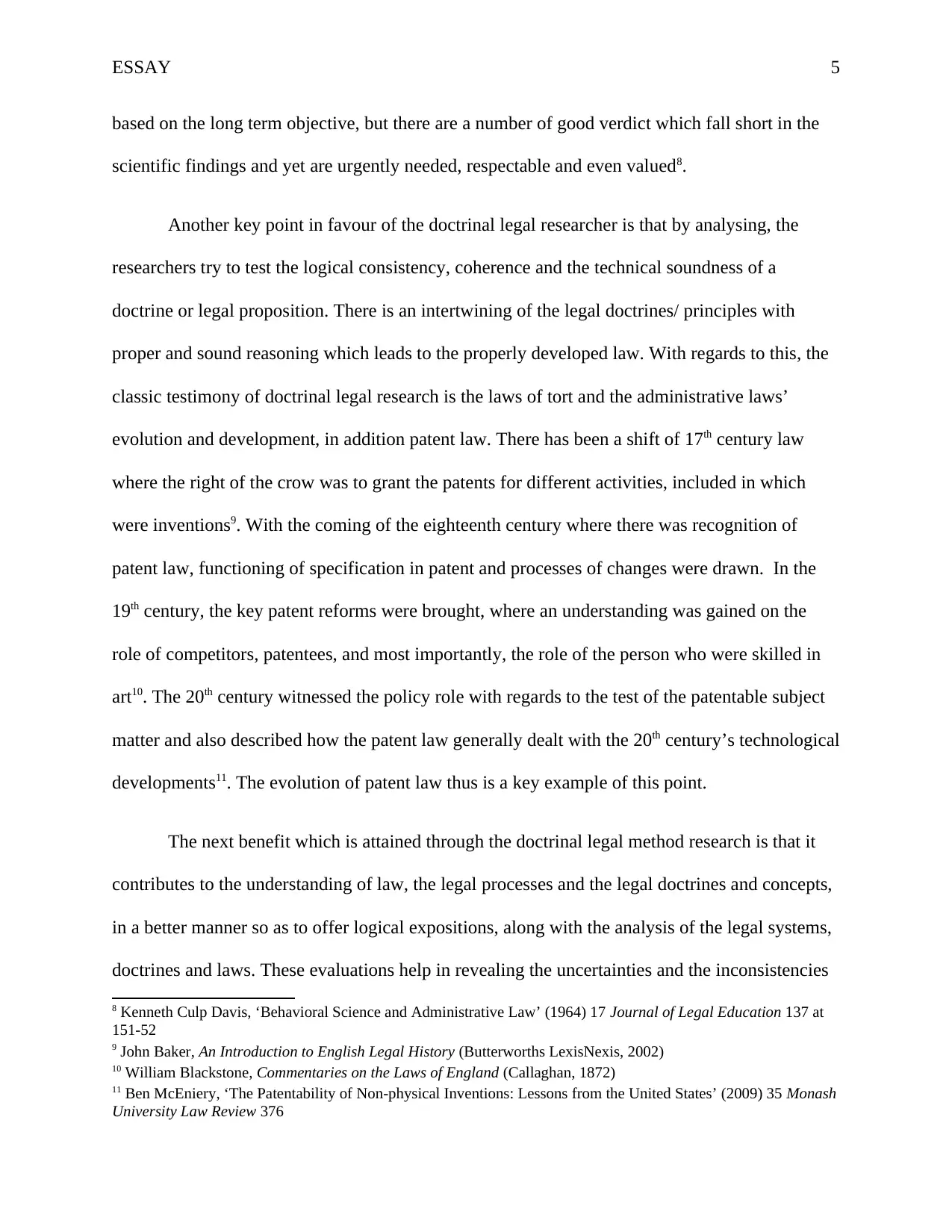
ESSAY 5
based on the long term objective, but there are a number of good verdict which fall short in the
scientific findings and yet are urgently needed, respectable and even valued8.
Another key point in favour of the doctrinal legal researcher is that by analysing, the
researchers try to test the logical consistency, coherence and the technical soundness of a
doctrine or legal proposition. There is an intertwining of the legal doctrines/ principles with
proper and sound reasoning which leads to the properly developed law. With regards to this, the
classic testimony of doctrinal legal research is the laws of tort and the administrative laws’
evolution and development, in addition patent law. There has been a shift of 17th century law
where the right of the crow was to grant the patents for different activities, included in which
were inventions9. With the coming of the eighteenth century where there was recognition of
patent law, functioning of specification in patent and processes of changes were drawn. In the
19th century, the key patent reforms were brought, where an understanding was gained on the
role of competitors, patentees, and most importantly, the role of the person who were skilled in
art10. The 20th century witnessed the policy role with regards to the test of the patentable subject
matter and also described how the patent law generally dealt with the 20th century’s technological
developments11. The evolution of patent law thus is a key example of this point.
The next benefit which is attained through the doctrinal legal method research is that it
contributes to the understanding of law, the legal processes and the legal doctrines and concepts,
in a better manner so as to offer logical expositions, along with the analysis of the legal systems,
doctrines and laws. These evaluations help in revealing the uncertainties and the inconsistencies
8 Kenneth Culp Davis, ‘Behavioral Science and Administrative Law’ (1964) 17 Journal of Legal Education 137 at
151-52
9 John Baker, An Introduction to English Legal History (Butterworths LexisNexis, 2002)
10 William Blackstone, Commentaries on the Laws of England (Callaghan, 1872)
11 Ben McEniery, ‘The Patentability of Non-physical Inventions: Lessons from the United States’ (2009) 35 Monash
University Law Review 376
based on the long term objective, but there are a number of good verdict which fall short in the
scientific findings and yet are urgently needed, respectable and even valued8.
Another key point in favour of the doctrinal legal researcher is that by analysing, the
researchers try to test the logical consistency, coherence and the technical soundness of a
doctrine or legal proposition. There is an intertwining of the legal doctrines/ principles with
proper and sound reasoning which leads to the properly developed law. With regards to this, the
classic testimony of doctrinal legal research is the laws of tort and the administrative laws’
evolution and development, in addition patent law. There has been a shift of 17th century law
where the right of the crow was to grant the patents for different activities, included in which
were inventions9. With the coming of the eighteenth century where there was recognition of
patent law, functioning of specification in patent and processes of changes were drawn. In the
19th century, the key patent reforms were brought, where an understanding was gained on the
role of competitors, patentees, and most importantly, the role of the person who were skilled in
art10. The 20th century witnessed the policy role with regards to the test of the patentable subject
matter and also described how the patent law generally dealt with the 20th century’s technological
developments11. The evolution of patent law thus is a key example of this point.
The next benefit which is attained through the doctrinal legal method research is that it
contributes to the understanding of law, the legal processes and the legal doctrines and concepts,
in a better manner so as to offer logical expositions, along with the analysis of the legal systems,
doctrines and laws. These evaluations help in revealing the uncertainties and the inconsistencies
8 Kenneth Culp Davis, ‘Behavioral Science and Administrative Law’ (1964) 17 Journal of Legal Education 137 at
151-52
9 John Baker, An Introduction to English Legal History (Butterworths LexisNexis, 2002)
10 William Blackstone, Commentaries on the Laws of England (Callaghan, 1872)
11 Ben McEniery, ‘The Patentability of Non-physical Inventions: Lessons from the United States’ (2009) 35 Monash
University Law Review 376
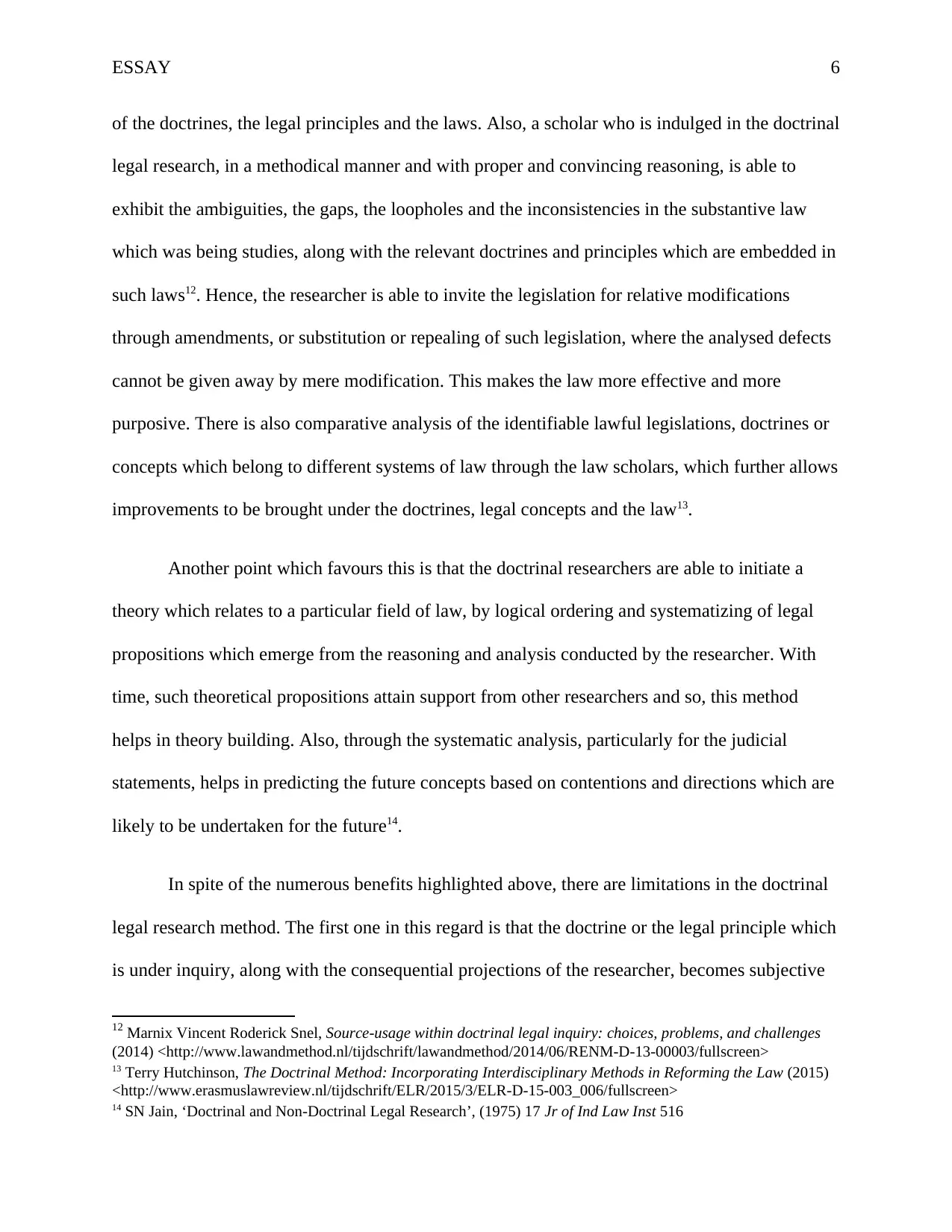
ESSAY 6
of the doctrines, the legal principles and the laws. Also, a scholar who is indulged in the doctrinal
legal research, in a methodical manner and with proper and convincing reasoning, is able to
exhibit the ambiguities, the gaps, the loopholes and the inconsistencies in the substantive law
which was being studies, along with the relevant doctrines and principles which are embedded in
such laws12. Hence, the researcher is able to invite the legislation for relative modifications
through amendments, or substitution or repealing of such legislation, where the analysed defects
cannot be given away by mere modification. This makes the law more effective and more
purposive. There is also comparative analysis of the identifiable lawful legislations, doctrines or
concepts which belong to different systems of law through the law scholars, which further allows
improvements to be brought under the doctrines, legal concepts and the law13.
Another point which favours this is that the doctrinal researchers are able to initiate a
theory which relates to a particular field of law, by logical ordering and systematizing of legal
propositions which emerge from the reasoning and analysis conducted by the researcher. With
time, such theoretical propositions attain support from other researchers and so, this method
helps in theory building. Also, through the systematic analysis, particularly for the judicial
statements, helps in predicting the future concepts based on contentions and directions which are
likely to be undertaken for the future14.
In spite of the numerous benefits highlighted above, there are limitations in the doctrinal
legal research method. The first one in this regard is that the doctrine or the legal principle which
is under inquiry, along with the consequential projections of the researcher, becomes subjective
12 Marnix Vincent Roderick Snel, Source-usage within doctrinal legal inquiry: choices, problems, and challenges
(2014) <http://www.lawandmethod.nl/tijdschrift/lawandmethod/2014/06/RENM-D-13-00003/fullscreen>
13 Terry Hutchinson, The Doctrinal Method: Incorporating Interdisciplinary Methods in Reforming the Law (2015)
<http://www.erasmuslawreview.nl/tijdschrift/ELR/2015/3/ELR-D-15-003_006/fullscreen>
14 SN Jain, ‘Doctrinal and Non-Doctrinal Legal Research’, (1975) 17 Jr of Ind Law Inst 516
of the doctrines, the legal principles and the laws. Also, a scholar who is indulged in the doctrinal
legal research, in a methodical manner and with proper and convincing reasoning, is able to
exhibit the ambiguities, the gaps, the loopholes and the inconsistencies in the substantive law
which was being studies, along with the relevant doctrines and principles which are embedded in
such laws12. Hence, the researcher is able to invite the legislation for relative modifications
through amendments, or substitution or repealing of such legislation, where the analysed defects
cannot be given away by mere modification. This makes the law more effective and more
purposive. There is also comparative analysis of the identifiable lawful legislations, doctrines or
concepts which belong to different systems of law through the law scholars, which further allows
improvements to be brought under the doctrines, legal concepts and the law13.
Another point which favours this is that the doctrinal researchers are able to initiate a
theory which relates to a particular field of law, by logical ordering and systematizing of legal
propositions which emerge from the reasoning and analysis conducted by the researcher. With
time, such theoretical propositions attain support from other researchers and so, this method
helps in theory building. Also, through the systematic analysis, particularly for the judicial
statements, helps in predicting the future concepts based on contentions and directions which are
likely to be undertaken for the future14.
In spite of the numerous benefits highlighted above, there are limitations in the doctrinal
legal research method. The first one in this regard is that the doctrine or the legal principle which
is under inquiry, along with the consequential projections of the researcher, becomes subjective
12 Marnix Vincent Roderick Snel, Source-usage within doctrinal legal inquiry: choices, problems, and challenges
(2014) <http://www.lawandmethod.nl/tijdschrift/lawandmethod/2014/06/RENM-D-13-00003/fullscreen>
13 Terry Hutchinson, The Doctrinal Method: Incorporating Interdisciplinary Methods in Reforming the Law (2015)
<http://www.erasmuslawreview.nl/tijdschrift/ELR/2015/3/ELR-D-15-003_006/fullscreen>
14 SN Jain, ‘Doctrinal and Non-Doctrinal Legal Research’, (1975) 17 Jr of Ind Law Inst 516
⊘ This is a preview!⊘
Do you want full access?
Subscribe today to unlock all pages.

Trusted by 1+ million students worldwide
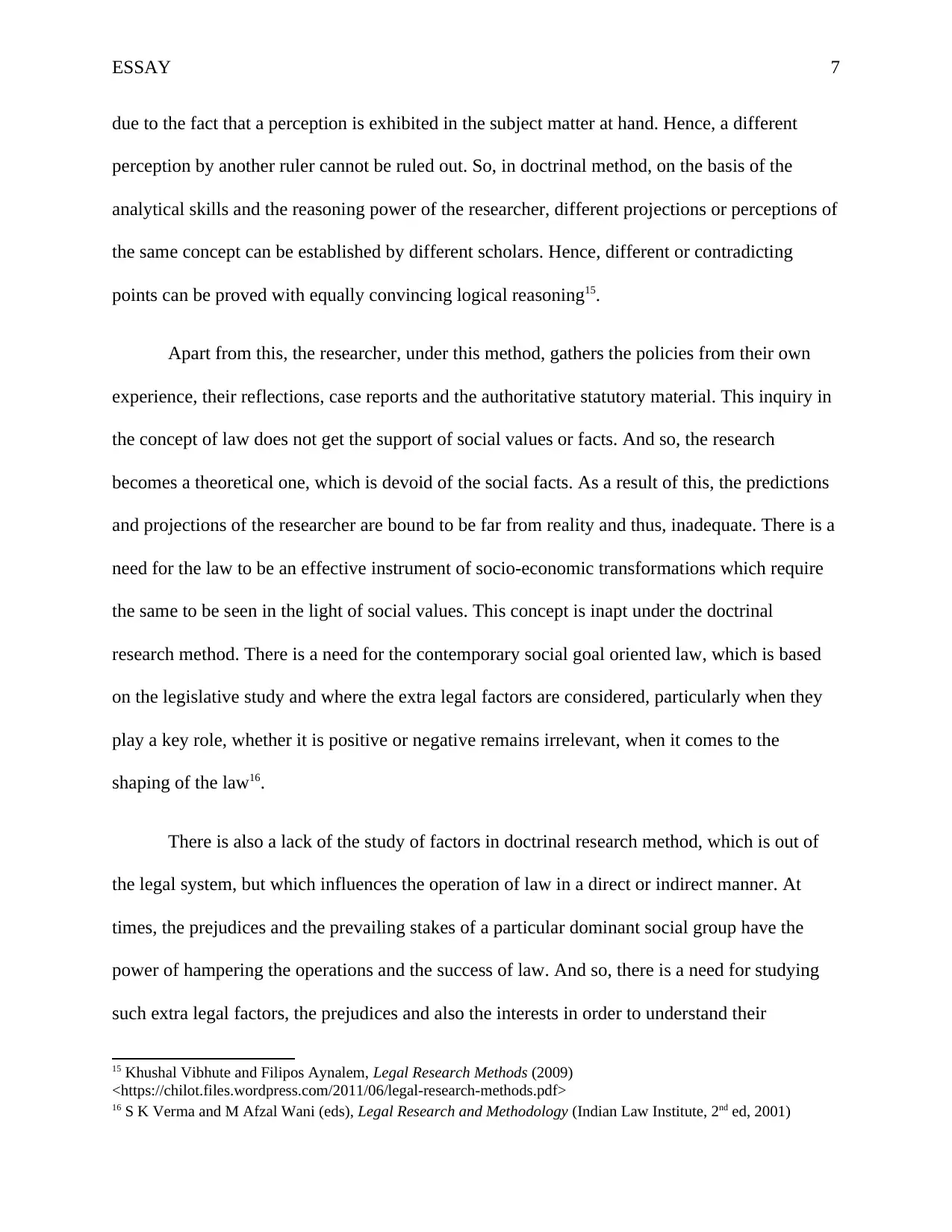
ESSAY 7
due to the fact that a perception is exhibited in the subject matter at hand. Hence, a different
perception by another ruler cannot be ruled out. So, in doctrinal method, on the basis of the
analytical skills and the reasoning power of the researcher, different projections or perceptions of
the same concept can be established by different scholars. Hence, different or contradicting
points can be proved with equally convincing logical reasoning15.
Apart from this, the researcher, under this method, gathers the policies from their own
experience, their reflections, case reports and the authoritative statutory material. This inquiry in
the concept of law does not get the support of social values or facts. And so, the research
becomes a theoretical one, which is devoid of the social facts. As a result of this, the predictions
and projections of the researcher are bound to be far from reality and thus, inadequate. There is a
need for the law to be an effective instrument of socio-economic transformations which require
the same to be seen in the light of social values. This concept is inapt under the doctrinal
research method. There is a need for the contemporary social goal oriented law, which is based
on the legislative study and where the extra legal factors are considered, particularly when they
play a key role, whether it is positive or negative remains irrelevant, when it comes to the
shaping of the law16.
There is also a lack of the study of factors in doctrinal research method, which is out of
the legal system, but which influences the operation of law in a direct or indirect manner. At
times, the prejudices and the prevailing stakes of a particular dominant social group have the
power of hampering the operations and the success of law. And so, there is a need for studying
such extra legal factors, the prejudices and also the interests in order to understand their
15 Khushal Vibhute and Filipos Aynalem, Legal Research Methods (2009)
<https://chilot.files.wordpress.com/2011/06/legal-research-methods.pdf>
16 S K Verma and M Afzal Wani (eds), Legal Research and Methodology (Indian Law Institute, 2nd ed, 2001)
due to the fact that a perception is exhibited in the subject matter at hand. Hence, a different
perception by another ruler cannot be ruled out. So, in doctrinal method, on the basis of the
analytical skills and the reasoning power of the researcher, different projections or perceptions of
the same concept can be established by different scholars. Hence, different or contradicting
points can be proved with equally convincing logical reasoning15.
Apart from this, the researcher, under this method, gathers the policies from their own
experience, their reflections, case reports and the authoritative statutory material. This inquiry in
the concept of law does not get the support of social values or facts. And so, the research
becomes a theoretical one, which is devoid of the social facts. As a result of this, the predictions
and projections of the researcher are bound to be far from reality and thus, inadequate. There is a
need for the law to be an effective instrument of socio-economic transformations which require
the same to be seen in the light of social values. This concept is inapt under the doctrinal
research method. There is a need for the contemporary social goal oriented law, which is based
on the legislative study and where the extra legal factors are considered, particularly when they
play a key role, whether it is positive or negative remains irrelevant, when it comes to the
shaping of the law16.
There is also a lack of the study of factors in doctrinal research method, which is out of
the legal system, but which influences the operation of law in a direct or indirect manner. At
times, the prejudices and the prevailing stakes of a particular dominant social group have the
power of hampering the operations and the success of law. And so, there is a need for studying
such extra legal factors, the prejudices and also the interests in order to understand their
15 Khushal Vibhute and Filipos Aynalem, Legal Research Methods (2009)
<https://chilot.files.wordpress.com/2011/06/legal-research-methods.pdf>
16 S K Verma and M Afzal Wani (eds), Legal Research and Methodology (Indian Law Institute, 2nd ed, 2001)
Paraphrase This Document
Need a fresh take? Get an instant paraphrase of this document with our AI Paraphraser
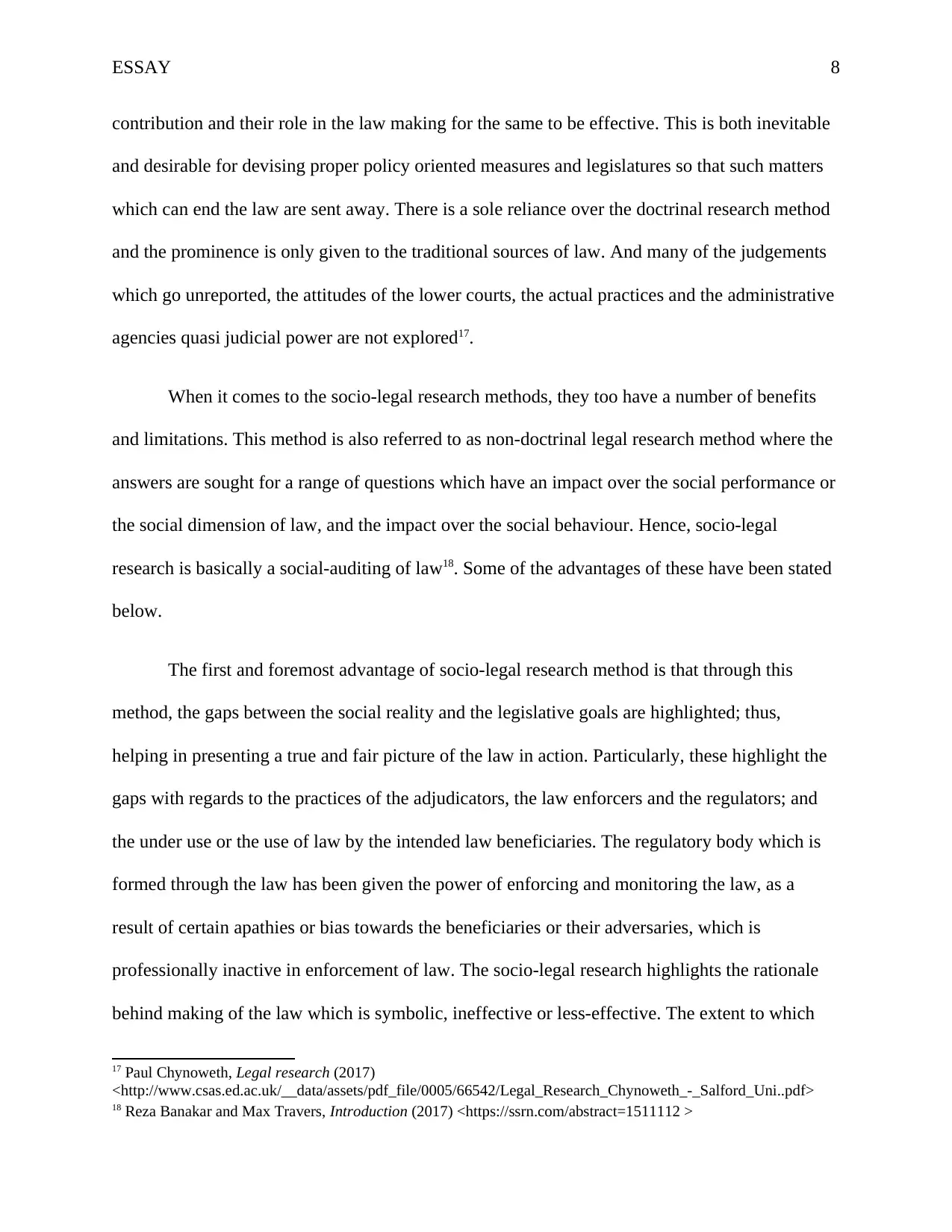
ESSAY 8
contribution and their role in the law making for the same to be effective. This is both inevitable
and desirable for devising proper policy oriented measures and legislatures so that such matters
which can end the law are sent away. There is a sole reliance over the doctrinal research method
and the prominence is only given to the traditional sources of law. And many of the judgements
which go unreported, the attitudes of the lower courts, the actual practices and the administrative
agencies quasi judicial power are not explored17.
When it comes to the socio-legal research methods, they too have a number of benefits
and limitations. This method is also referred to as non-doctrinal legal research method where the
answers are sought for a range of questions which have an impact over the social performance or
the social dimension of law, and the impact over the social behaviour. Hence, socio-legal
research is basically a social-auditing of law18. Some of the advantages of these have been stated
below.
The first and foremost advantage of socio-legal research method is that through this
method, the gaps between the social reality and the legislative goals are highlighted; thus,
helping in presenting a true and fair picture of the law in action. Particularly, these highlight the
gaps with regards to the practices of the adjudicators, the law enforcers and the regulators; and
the under use or the use of law by the intended law beneficiaries. The regulatory body which is
formed through the law has been given the power of enforcing and monitoring the law, as a
result of certain apathies or bias towards the beneficiaries or their adversaries, which is
professionally inactive in enforcement of law. The socio-legal research highlights the rationale
behind making of the law which is symbolic, ineffective or less-effective. The extent to which
17 Paul Chynoweth, Legal research (2017)
<http://www.csas.ed.ac.uk/__data/assets/pdf_file/0005/66542/Legal_Research_Chynoweth_-_Salford_Uni..pdf>
18 Reza Banakar and Max Travers, Introduction (2017) <https://ssrn.com/abstract=1511112 >
contribution and their role in the law making for the same to be effective. This is both inevitable
and desirable for devising proper policy oriented measures and legislatures so that such matters
which can end the law are sent away. There is a sole reliance over the doctrinal research method
and the prominence is only given to the traditional sources of law. And many of the judgements
which go unreported, the attitudes of the lower courts, the actual practices and the administrative
agencies quasi judicial power are not explored17.
When it comes to the socio-legal research methods, they too have a number of benefits
and limitations. This method is also referred to as non-doctrinal legal research method where the
answers are sought for a range of questions which have an impact over the social performance or
the social dimension of law, and the impact over the social behaviour. Hence, socio-legal
research is basically a social-auditing of law18. Some of the advantages of these have been stated
below.
The first and foremost advantage of socio-legal research method is that through this
method, the gaps between the social reality and the legislative goals are highlighted; thus,
helping in presenting a true and fair picture of the law in action. Particularly, these highlight the
gaps with regards to the practices of the adjudicators, the law enforcers and the regulators; and
the under use or the use of law by the intended law beneficiaries. The regulatory body which is
formed through the law has been given the power of enforcing and monitoring the law, as a
result of certain apathies or bias towards the beneficiaries or their adversaries, which is
professionally inactive in enforcement of law. The socio-legal research highlights the rationale
behind making of the law which is symbolic, ineffective or less-effective. The extent to which
17 Paul Chynoweth, Legal research (2017)
<http://www.csas.ed.ac.uk/__data/assets/pdf_file/0005/66542/Legal_Research_Chynoweth_-_Salford_Uni..pdf>
18 Reza Banakar and Max Travers, Introduction (2017) <https://ssrn.com/abstract=1511112 >
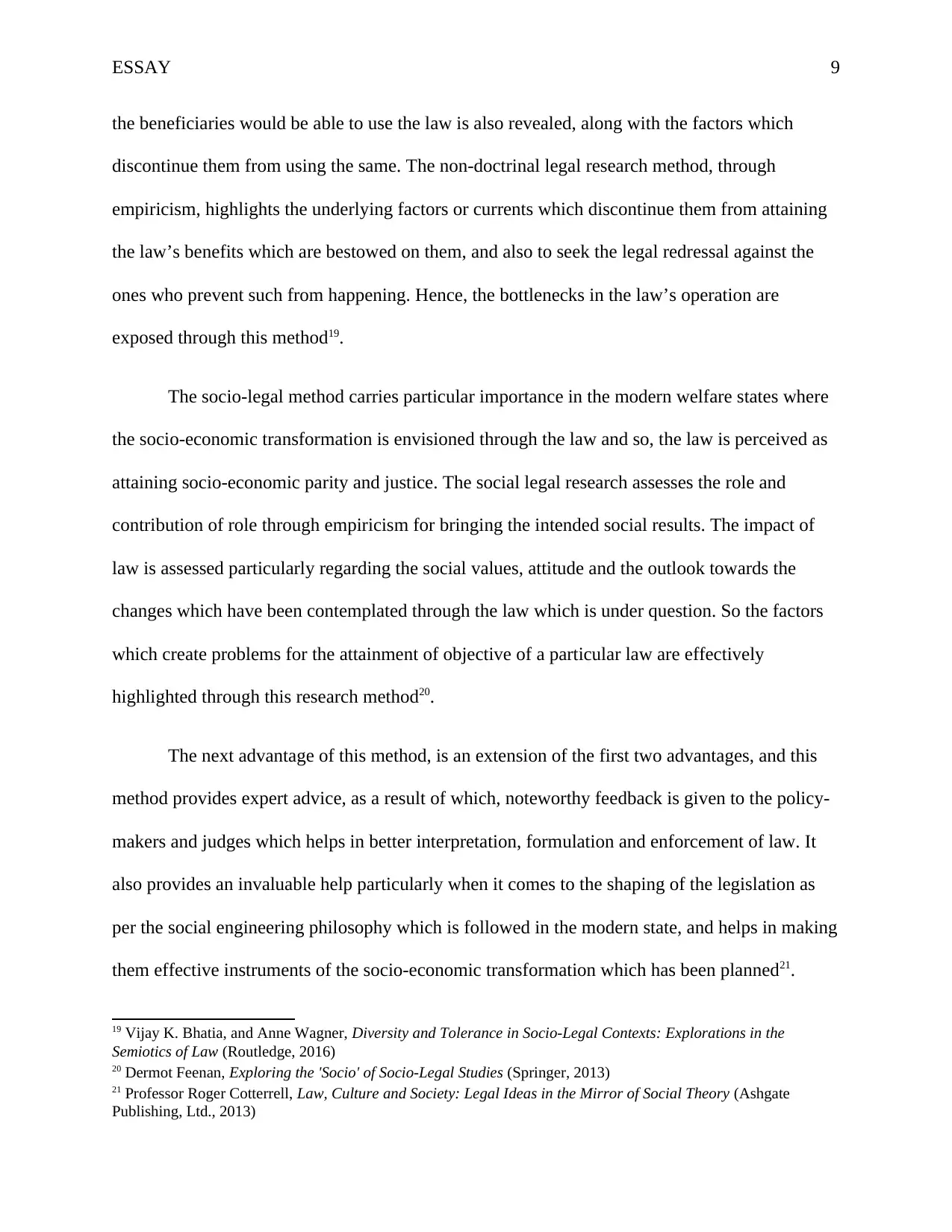
ESSAY 9
the beneficiaries would be able to use the law is also revealed, along with the factors which
discontinue them from using the same. The non-doctrinal legal research method, through
empiricism, highlights the underlying factors or currents which discontinue them from attaining
the law’s benefits which are bestowed on them, and also to seek the legal redressal against the
ones who prevent such from happening. Hence, the bottlenecks in the law’s operation are
exposed through this method19.
The socio-legal method carries particular importance in the modern welfare states where
the socio-economic transformation is envisioned through the law and so, the law is perceived as
attaining socio-economic parity and justice. The social legal research assesses the role and
contribution of role through empiricism for bringing the intended social results. The impact of
law is assessed particularly regarding the social values, attitude and the outlook towards the
changes which have been contemplated through the law which is under question. So the factors
which create problems for the attainment of objective of a particular law are effectively
highlighted through this research method20.
The next advantage of this method, is an extension of the first two advantages, and this
method provides expert advice, as a result of which, noteworthy feedback is given to the policy-
makers and judges which helps in better interpretation, formulation and enforcement of law. It
also provides an invaluable help particularly when it comes to the shaping of the legislation as
per the social engineering philosophy which is followed in the modern state, and helps in making
them effective instruments of the socio-economic transformation which has been planned21.
19 Vijay K. Bhatia, and Anne Wagner, Diversity and Tolerance in Socio-Legal Contexts: Explorations in the
Semiotics of Law (Routledge, 2016)
20 Dermot Feenan, Exploring the 'Socio' of Socio-Legal Studies (Springer, 2013)
21 Professor Roger Cotterrell, Law, Culture and Society: Legal Ideas in the Mirror of Social Theory (Ashgate
Publishing, Ltd., 2013)
the beneficiaries would be able to use the law is also revealed, along with the factors which
discontinue them from using the same. The non-doctrinal legal research method, through
empiricism, highlights the underlying factors or currents which discontinue them from attaining
the law’s benefits which are bestowed on them, and also to seek the legal redressal against the
ones who prevent such from happening. Hence, the bottlenecks in the law’s operation are
exposed through this method19.
The socio-legal method carries particular importance in the modern welfare states where
the socio-economic transformation is envisioned through the law and so, the law is perceived as
attaining socio-economic parity and justice. The social legal research assesses the role and
contribution of role through empiricism for bringing the intended social results. The impact of
law is assessed particularly regarding the social values, attitude and the outlook towards the
changes which have been contemplated through the law which is under question. So the factors
which create problems for the attainment of objective of a particular law are effectively
highlighted through this research method20.
The next advantage of this method, is an extension of the first two advantages, and this
method provides expert advice, as a result of which, noteworthy feedback is given to the policy-
makers and judges which helps in better interpretation, formulation and enforcement of law. It
also provides an invaluable help particularly when it comes to the shaping of the legislation as
per the social engineering philosophy which is followed in the modern state, and helps in making
them effective instruments of the socio-economic transformation which has been planned21.
19 Vijay K. Bhatia, and Anne Wagner, Diversity and Tolerance in Socio-Legal Contexts: Explorations in the
Semiotics of Law (Routledge, 2016)
20 Dermot Feenan, Exploring the 'Socio' of Socio-Legal Studies (Springer, 2013)
21 Professor Roger Cotterrell, Law, Culture and Society: Legal Ideas in the Mirror of Social Theory (Ashgate
Publishing, Ltd., 2013)
⊘ This is a preview!⊘
Do you want full access?
Subscribe today to unlock all pages.

Trusted by 1+ million students worldwide
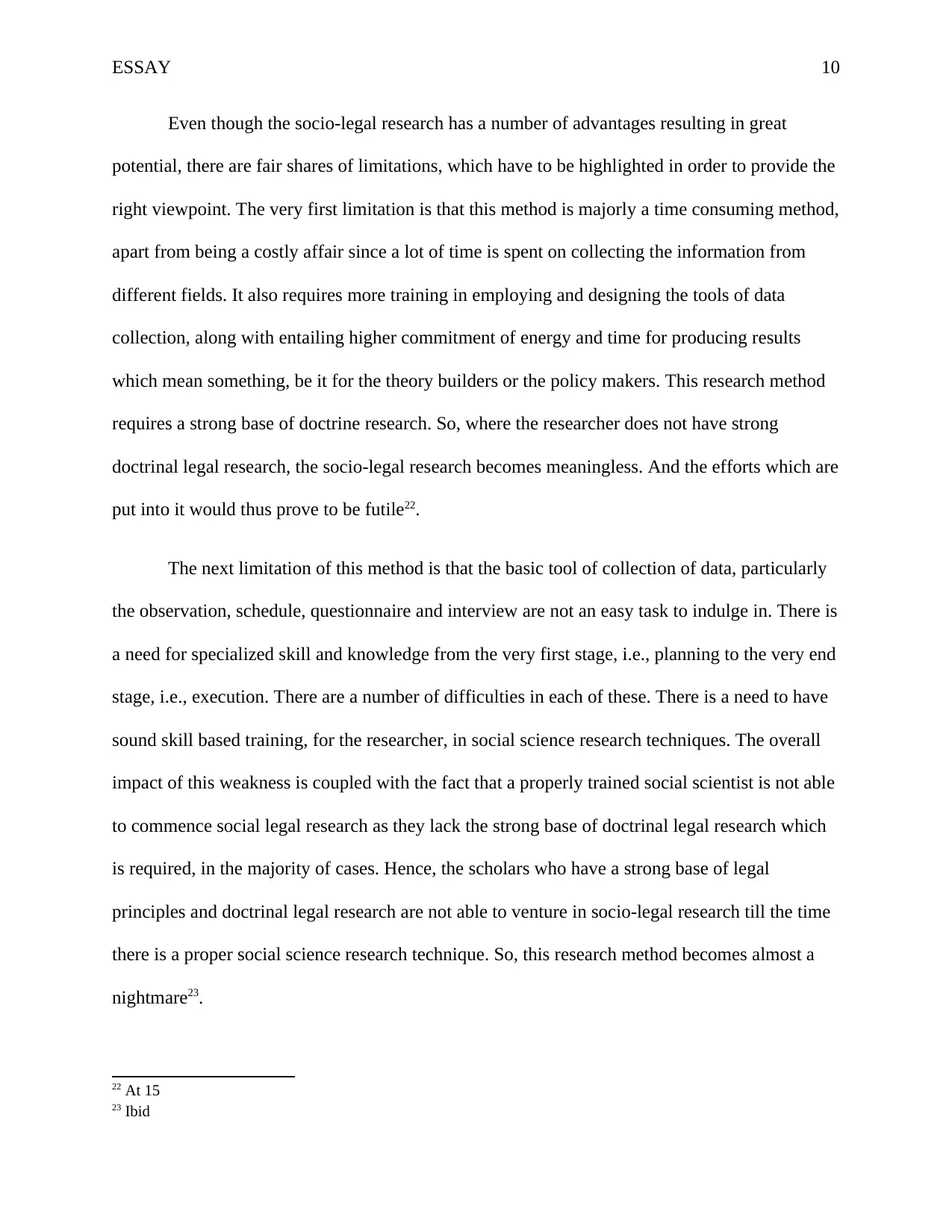
ESSAY 10
Even though the socio-legal research has a number of advantages resulting in great
potential, there are fair shares of limitations, which have to be highlighted in order to provide the
right viewpoint. The very first limitation is that this method is majorly a time consuming method,
apart from being a costly affair since a lot of time is spent on collecting the information from
different fields. It also requires more training in employing and designing the tools of data
collection, along with entailing higher commitment of energy and time for producing results
which mean something, be it for the theory builders or the policy makers. This research method
requires a strong base of doctrine research. So, where the researcher does not have strong
doctrinal legal research, the socio-legal research becomes meaningless. And the efforts which are
put into it would thus prove to be futile22.
The next limitation of this method is that the basic tool of collection of data, particularly
the observation, schedule, questionnaire and interview are not an easy task to indulge in. There is
a need for specialized skill and knowledge from the very first stage, i.e., planning to the very end
stage, i.e., execution. There are a number of difficulties in each of these. There is a need to have
sound skill based training, for the researcher, in social science research techniques. The overall
impact of this weakness is coupled with the fact that a properly trained social scientist is not able
to commence social legal research as they lack the strong base of doctrinal legal research which
is required, in the majority of cases. Hence, the scholars who have a strong base of legal
principles and doctrinal legal research are not able to venture in socio-legal research till the time
there is a proper social science research technique. So, this research method becomes almost a
nightmare23.
22 At 15
23 Ibid
Even though the socio-legal research has a number of advantages resulting in great
potential, there are fair shares of limitations, which have to be highlighted in order to provide the
right viewpoint. The very first limitation is that this method is majorly a time consuming method,
apart from being a costly affair since a lot of time is spent on collecting the information from
different fields. It also requires more training in employing and designing the tools of data
collection, along with entailing higher commitment of energy and time for producing results
which mean something, be it for the theory builders or the policy makers. This research method
requires a strong base of doctrine research. So, where the researcher does not have strong
doctrinal legal research, the socio-legal research becomes meaningless. And the efforts which are
put into it would thus prove to be futile22.
The next limitation of this method is that the basic tool of collection of data, particularly
the observation, schedule, questionnaire and interview are not an easy task to indulge in. There is
a need for specialized skill and knowledge from the very first stage, i.e., planning to the very end
stage, i.e., execution. There are a number of difficulties in each of these. There is a need to have
sound skill based training, for the researcher, in social science research techniques. The overall
impact of this weakness is coupled with the fact that a properly trained social scientist is not able
to commence social legal research as they lack the strong base of doctrinal legal research which
is required, in the majority of cases. Hence, the scholars who have a strong base of legal
principles and doctrinal legal research are not able to venture in socio-legal research till the time
there is a proper social science research technique. So, this research method becomes almost a
nightmare23.
22 At 15
23 Ibid
Paraphrase This Document
Need a fresh take? Get an instant paraphrase of this document with our AI Paraphraser
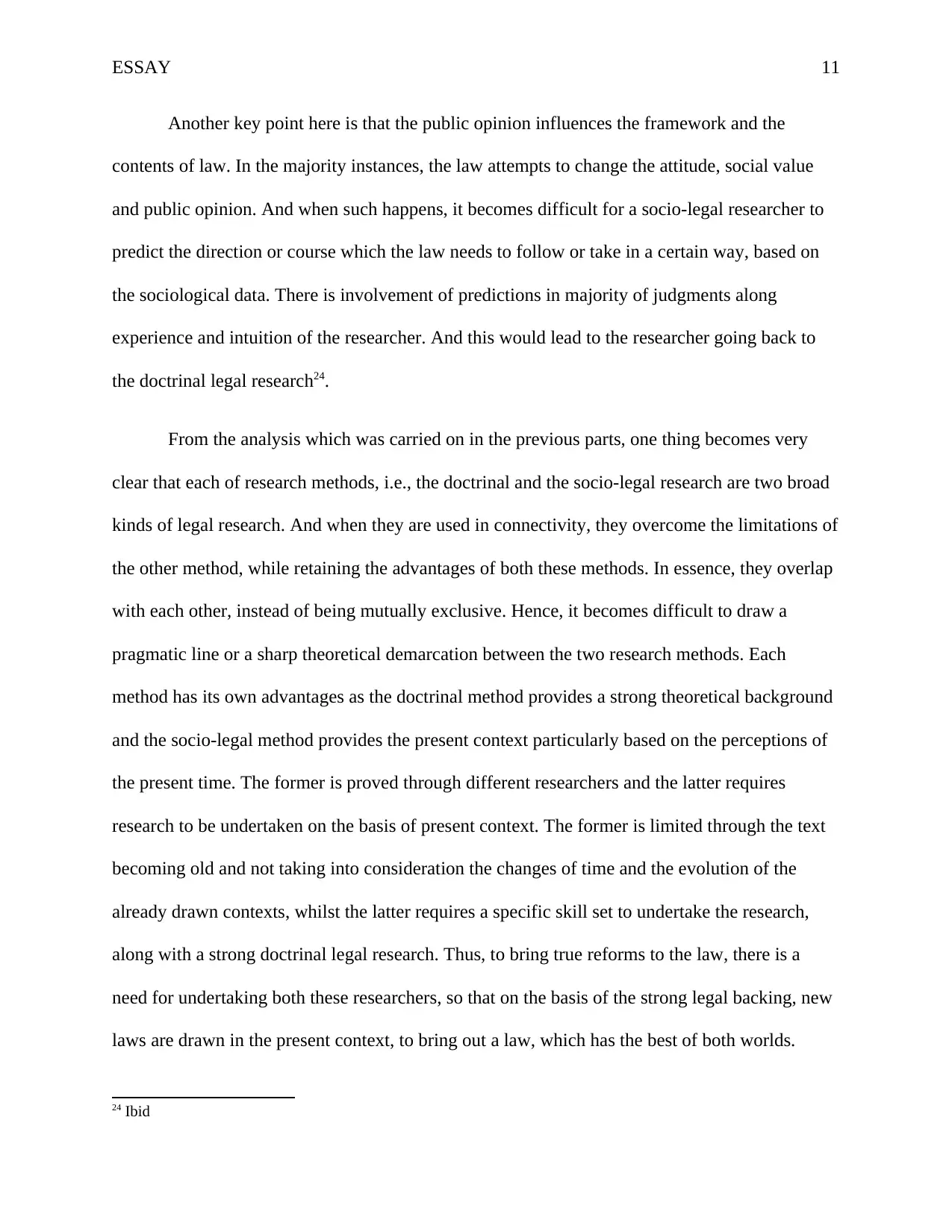
ESSAY 11
Another key point here is that the public opinion influences the framework and the
contents of law. In the majority instances, the law attempts to change the attitude, social value
and public opinion. And when such happens, it becomes difficult for a socio-legal researcher to
predict the direction or course which the law needs to follow or take in a certain way, based on
the sociological data. There is involvement of predictions in majority of judgments along
experience and intuition of the researcher. And this would lead to the researcher going back to
the doctrinal legal research24.
From the analysis which was carried on in the previous parts, one thing becomes very
clear that each of research methods, i.e., the doctrinal and the socio-legal research are two broad
kinds of legal research. And when they are used in connectivity, they overcome the limitations of
the other method, while retaining the advantages of both these methods. In essence, they overlap
with each other, instead of being mutually exclusive. Hence, it becomes difficult to draw a
pragmatic line or a sharp theoretical demarcation between the two research methods. Each
method has its own advantages as the doctrinal method provides a strong theoretical background
and the socio-legal method provides the present context particularly based on the perceptions of
the present time. The former is proved through different researchers and the latter requires
research to be undertaken on the basis of present context. The former is limited through the text
becoming old and not taking into consideration the changes of time and the evolution of the
already drawn contexts, whilst the latter requires a specific skill set to undertake the research,
along with a strong doctrinal legal research. Thus, to bring true reforms to the law, there is a
need for undertaking both these researchers, so that on the basis of the strong legal backing, new
laws are drawn in the present context, to bring out a law, which has the best of both worlds.
24 Ibid
Another key point here is that the public opinion influences the framework and the
contents of law. In the majority instances, the law attempts to change the attitude, social value
and public opinion. And when such happens, it becomes difficult for a socio-legal researcher to
predict the direction or course which the law needs to follow or take in a certain way, based on
the sociological data. There is involvement of predictions in majority of judgments along
experience and intuition of the researcher. And this would lead to the researcher going back to
the doctrinal legal research24.
From the analysis which was carried on in the previous parts, one thing becomes very
clear that each of research methods, i.e., the doctrinal and the socio-legal research are two broad
kinds of legal research. And when they are used in connectivity, they overcome the limitations of
the other method, while retaining the advantages of both these methods. In essence, they overlap
with each other, instead of being mutually exclusive. Hence, it becomes difficult to draw a
pragmatic line or a sharp theoretical demarcation between the two research methods. Each
method has its own advantages as the doctrinal method provides a strong theoretical background
and the socio-legal method provides the present context particularly based on the perceptions of
the present time. The former is proved through different researchers and the latter requires
research to be undertaken on the basis of present context. The former is limited through the text
becoming old and not taking into consideration the changes of time and the evolution of the
already drawn contexts, whilst the latter requires a specific skill set to undertake the research,
along with a strong doctrinal legal research. Thus, to bring true reforms to the law, there is a
need for undertaking both these researchers, so that on the basis of the strong legal backing, new
laws are drawn in the present context, to bring out a law, which has the best of both worlds.
24 Ibid

ESSAY 12
⊘ This is a preview!⊘
Do you want full access?
Subscribe today to unlock all pages.

Trusted by 1+ million students worldwide
1 out of 15
Related Documents
Your All-in-One AI-Powered Toolkit for Academic Success.
+13062052269
info@desklib.com
Available 24*7 on WhatsApp / Email
![[object Object]](/_next/static/media/star-bottom.7253800d.svg)
Unlock your academic potential
Copyright © 2020–2025 A2Z Services. All Rights Reserved. Developed and managed by ZUCOL.




